All over the Southwest the thrifty city of Carlsbad, the county seat of Eddy County, is known as Carlsbad the Beautiful. Stately shade trees overarch the broad, well kept streets, even in the business sections of the town, while the residence section, with homes enveloped in shade and flowering plants and shrubs, has made the residences of Carlsbad justly celebrated throughout the state. Commercial thrift has furnished Carlsbad with substantial business blocks, good hotels and handsome public buildings with the usual accessories of a modern up-to-date community. A complete waterworks system furnishes every house in town with city water; an electric light and power system furnishes light and power. The population is about 4000, and the city, like other sister towns of the Pecos Valley, owes its rise to irrigation.
A famous mammoth medical spring, a short distance northwest of the city, has given it the name of Carlsbad. It is said that the waters of this spring, under chemical analysis, show properties similar to those of the celebrated Carlsbad Springs in Austria which suggested the present name for the town. This spring breaks out of the bank of the Pecos River near Carlsbad and the water is justly famed for its pleasant taste and splendid results in all kidney and stomach troubles. In recent years much of this water has been stored and shipped; yet treatment with accommodations, such as a modern sanitarium and health resort alone can afford, is one of the future possibilities of this mineral spring:. A salt lake southeast of Carlsbad offers similar opportunities.
Just below the mineral spring a gigantic artificial flume spans the Pecos River, carrying all the water for irrigation purposes under the so called Carlsbad Project. This reclamation project, diverting the waters of the Pecos River into the Avalon Dam and thence to the canals, was recently constructed at a cost of half a million dollars on the part of the U. S. Government, which also controls its operation. It brings about 20,000 acres under irrigation and the canals and laterals of this project spread far and away over the towns of Carlsbad, La Huerta, Otis, Loving and Malaga. Through this life giving nutriment the soil grows abundant crops of alfalfa, cotton, sweet potatoes, cantaloupes and all other sorts of fruits and vegetables.
Carlsbad is justly famed as a health resort. Its elevation is 3120 feet. The sun shines almost all the days of the year and the dry atmosphere is life giving and healthful. Indeed, a physician writes: “It is the best and most healthful climate in the United States, where one may live in the open all the year and enjoy almost perpetual sunshine and yet never suffer from the heat while in the shade. Our climate is not only a panacea for tuberculosis and all kindred diseases, but by its tonication it benefits or cures most chronic conditions, and our mineral waters have cured many supposedly incurable cases of stomach and kidney diseases.”
From these introductory remarks it may safely be inferred that the material status of Carlsbad is in a most flourishing condition. Sad to say, the spiritual prosperity of the Catholic Church does not measure up to the same high standards, and this for a variety of causes. Among these, however, will not be found lack of effort and continual sacrifice on the part of the Franciscan Fathers who are in charge of the missions of Carlsbad and Eddy County. Unfortunately it was not the Catholic element which here and in other communities of the Southwest has profited to any appreciable extent by the material progress made within the last years, for here as in the entire Southwest the majority of Catholics belong to the poor and unprogressive Mexican population. The parish of Carlsbad, belonging to the Diocese of Tucson, is coextensive with Eddy County; a trifle of only 7000 square miles with a population of 12,000 souls (U. S. Census of 1910).This in itself is a serious drawback to effective pastoration. The denominational lines are, like everywhere in the Southwest, sharply drawn: Americans, mostly Non-Catholics, Mexicans, mostly ought-to-be Catholics.
The majority of these Mexicans are former residents of Old Mexico, from Chihuahua and others of the poorest and lowest Border States. They drifted into this part of New Mexico through Texas. Long before the settling of the county by Americans, when Eddy County, according to the picturesque description of an old settler, was “nothing but a howling wilderness”, these people roamed about here as nomadic herders, sheep raisers or in temporary camps. There were no towns, no railroads, no communication with the surrounding civilization; much less churches or schools. Regular pastoration of these unfortunate waifs could not be thought of or attempted; small wonder, therefore, that little of faith had remained with them beyond their consciousness of being Catholics.
In July, 1889, the present town of Carlsbad was founded by Mr. Chas. B. Eddy on the banks of the Pecos River. It was named Eddy after the founder. A settlement of Mexicans arose on the opposite bank of the river, consisting of a motley camp of shacks, tents ami dugouts, which was called, significantly enough, Chihuahua. In 1892 the Mexicans broke camp and moved across the river where, they laid the foundation of another notorious shanty town named Phenix. Still later they moved even closer to Carlsbad, to what is now San .lose. The history of Carlsbad, as will be seen, though short, was sufficiently wild and eventful. Conditions in Phenix in these “good(?) old times’1 were simply appalling. It was the abode of low dives and their accompaniment: lawlessness, disorder and debauchery. The little settlement of about 150 souls could boast of 5 saloons. Gambling dens and houses of ill fame were the other resorts of this “veritable Sodom and Gomorrah”, as it has been described by an old pioneer. A town that can boast of such an aggregation of dens of wickedness would soon establish an unenviable record for crime. As a matter of fact anyone visiting Phenix took his life into his hands. Drunken brawls, stabbing, shooting and killing affrays were the order of the day. No less than 18 murder cases within two years were found on the criminal docket of Eddy County, the guilty ones belonging mostly to the Mexican population. A triple killing, two Mexicans and one American saloon-keeper being shot dead in one night, brought matters to a crisis in November, 1896.
The town was abandoned and at this writing only two rickety houses and a number of adobe ruins mark the sight of one of the wildest towns of the wild and wooly West. San .lose, the successor of these dark and bloody grounds, is a well ordered community in comparison, but even here a movement towards annexation started in Carlsbad in 1912, with a view to eliminate the curse of the Mexican population, the saloons, was defeated by the Mexicans.
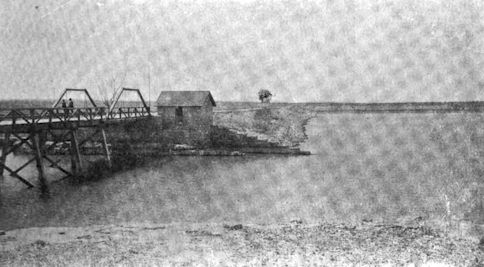
Avalon Dam, Carlsbad, New Mexico
It will easily be seen how difficult a task the Catholic Church was called upon to solve.
The first Catholic priest to set foot into the vicinity of present Carlsbad was sent thither by Bishop Bourgade in 1890. It is a sad testimony to the interest shown in his ministrations by his wayward flock, that writer of this could not even ascertain his name from the Mexican parishioners. He did not stay very long, finding it impossible to succeed with the element entrusted to his care, who did not even provide a bare livelihood for their pastor. He therefore returned to his former charge at S. Elceario (San Elizario?), Texas, as appears from a letter of Archbishop Bourgade, then Vicar Apostolic of Tucson, to Mr. H. Mullane, written in 1893. It was, however, during the short ministry of this unknown pastor that Mr. Eddy, the founder of the town, donated two building lots on the corner of Guadalupe and Shaw Strs., together with a sum of $100 towards the erection of a Catholic Church. The building was begun on the 22nd of dune, 1891, but soon had to be interrupted until November, 1893, when the building of a Church on the old foundation was resumed in earnest.
With the opening of the Pecos Valley Railroad into Eddy, January, 1891, a marked improvement of local conditions set in. In December, 1892, Rev. Charles M. Pinto, S. J., came from El Paso, Texas, on a sick call, a distance of 300 miles and, for the first time after a long interruption, offered the Holy Sacrifice of the Mass at the residence of W.H. Mullane (“Current” Printing Office) In 1893, at the request of Bishop Bourgade, the Carmelite Fathers of Marienfeld, (now Stanton) Texas, took charge of Eddy. They visited it monthly, saying mass in an empty store or a schoolhouse until December 23rd, 1893, when the present St. Edward’s church, a rock structure, was dedicated. Services were held for the few American and many Mexican Catholics either together or as separate congregations, as conditions made it advisable. Later a chapel was built for the Mexican congregation at San José. The Carmelite Fathers continued their ministrations until September, 1895.
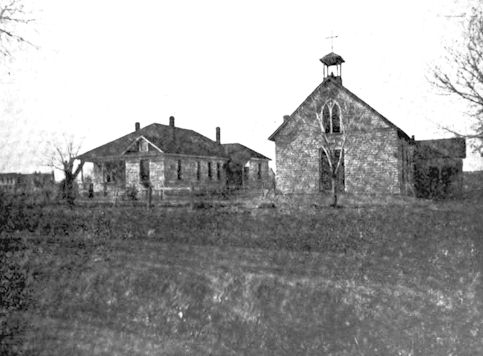
St. Edward’s Church and Pastoral Residence
In January, 1896, Bishop Bourgade secured the services of a young priest from Iowa, whom he appointed first resident priest of Eddy. This was the Rev. Herman Kempker, a very zealous and indefatigable worker for the salvation of souls and an apostle among the poor Mexicans. His best efforts were spent for their moral and social uplift. He was in truth a kind father to them, and they in return revered him sincerely. In September, 1896, Father Kempker acquired ten acres of land from the Pecos Valley Irrigation Co. and had it surveyed and platted for the purpose of drawing away the Mexicans from the evil surroundings at Phenix to this new and clean home which he called San Jose”. As we have seen before, he partially succeeded. Unfortunately Father Kempker, being a sufferer from pulmonary tuberculosis, lived all too short. He was called to his eternal reward on May 3, 1899, at the early age of 34 years.
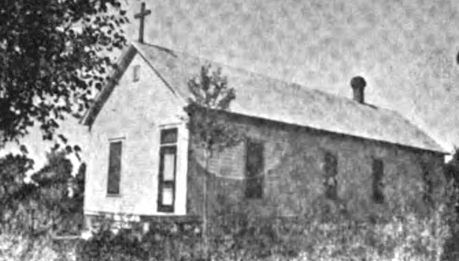
Church of Artesia, New Mexico
The same month and year the name of Eddy was changed into that of Carlsbad.
After the death of Father Kempker the Carmelite Fathers once more took charge of Carlsbad, only for a short time, however. In 1901 they withdrew definitely from Stanton, Texas, the Fathers returning to their former houses and missions in Kansas and Louisiana.
In July, 1901, Rev. Joseph Hoban, who had succeeded the Carmelites at Stanton, began to visit Carlsbad and the Mexican Missions once a month. It was he who laid the foundation to the present adobe chapel for the Mexican settlement in San José in 1902.

Church of Artesia, New Mexico
The Franciscan Fathers accepted the call of the Rev. Bishop in June, 1903, and visited Carlsbad at first from Roswell, N. M., where they had established a residence shortly before. Whole Eddy County was given to their spiritual administration, and the missions at Carlsbad, San José and the small Mexican and Italian settlements on the plains north and south of Carlsbad were ministered to as frequently as possible. Rev. Fr. Eligius finished the chapel at San Jose; his successor, Fr. Juvenal, who since has passed to his eternal reward, began and completed the residence at Carlsbad near St. Edward’s Church and founded the mission at Artesia which received its name from the Artesian Springs discovered in that locality. The chapel built at Artesia had to be enlarged during the pastorate of Fr. Robert, who succeeded Fr. Juvenal.
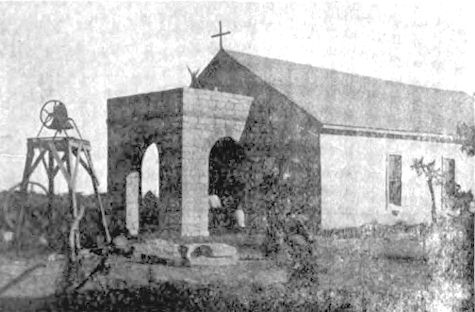
San José Church with Unfinished Tower
St. Edward’s Church for the English speaking Catholics at Carlsbad, in charge of the Rev. Gilbert Schulte, is rather small parish, but it constitutes the headquarters from which the missions and mission stations of Eddy County are administered, namely: Artesia, Dayton, Hope and Lakewood, attended by the Rev. Lawrence Rossmann, and Florence, Loving, Malaga, Ojo Azul and the Mexican parish of San Jose, adjoining Carlsbad, attended by the Rev. Arbogast Reissler. Besides St. Edward’s Church of Carlsbad there are three other churches or chapels in Eddy County, the church at Artesia, the little adobe house at Dayton, which has been secured lately to serve as a chapel, and the church at San José. The latter is, however, in so unsafe a condition, that it is kept from collapsing only by means of rock heaps piled up against the walls. All the other missions have no other places of worship than the adobe huts or shacks of the poor Mexicans.
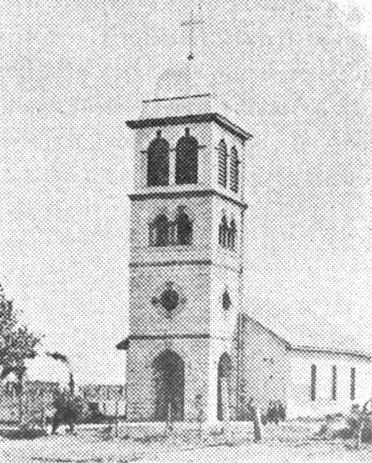
San José Church
Since August, 1907, Rev. Fr. Arbogast Reissler, O. F. M., is in charge of the Mexican congregation of San .lose”, at Carlsbad. Many improvements have been made since then, largely through the personal labor of the Rev. pastor, as the church had absolutely nothing beyond the four walls, the floor and the roof. A pretty altar and a number of pews were presented by the Sisters of the Most Precious Blood. Through donations from friends in the East and collections among the people we were enabled to build a tower and install bells. As far as their humble means permitted, the Mexicans have contributed their full share of the wherewithal. In order to create a genuine Catholic spirit in the congregation religious societies and sodalities were founded and the existing Sacred Heart League was encouraged.
The most important problem on our hands just now is the rebuilding of the church which, as mentioned before, has fallen into utter ruin and decay. Without outside help this cannot be done. Even the present humble achievements would have been impossible without the hard personal drudgery of the Rev. pastor. To save every possible cent for the building of the future church, the chapel has been without ceiling, floor, sacristy and in winter, without heat for all these years. Here like in the other places attended by them in the Southwest it is the self-sacrificing spirit of the Fathers that has largely brought about the results visible, a life of hardships and deprivations for the sake of the good cause. Often the Fathers have to doff the religious garb for a pair of overalls, and put aside books and clerical studies for the tools of every trade under the sun.
However, God and good friends helping, we expect to continue plodding and working with whatever poor and scant resources we have on hand, to build a substantial church of rock, and to form a truly Christian congregation of living temples of the Holy Ghost.
May this little sketch arouse the interest of our brethren in the Order as well as in the congregations under their charge who, placed amidst more favorable surroundings, are apt to overlook their obligations towards their less fortunate fellow Catholics in the Foreign Missions right here at home! It will then not have failed of its purpose.
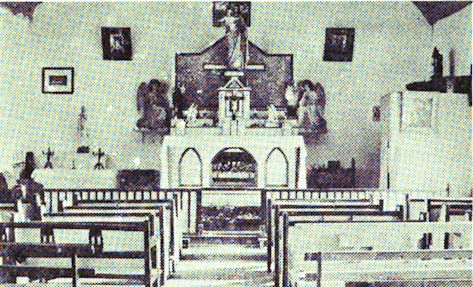
Interior of San José Church
Source: The Franciscan Missions of the Southwest, Published annually by the Franciscan Fathers at Saint Michaels, Arizona, 1917.
